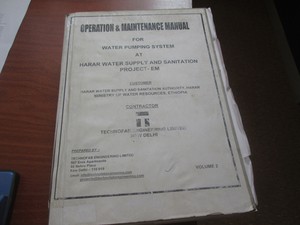The Operation and Maintenance Manual
A key element of ensuring timely and adequate maintenance of water treatment and supply systems is the Operation and Maintenance Manual (Figure 6.6). This manual is prepared immediately after construction begins and before operation starts, and is the basis for the day-to-day running of the system.

Figure 6.6 A typical Operation and Maintenance Manual.
A well-prepared Operation and Maintenance Manual contains the following:
- A detailed description of the system, with drawings.
- Health and Safety advice for all aspects of the water treatment and supply operation, ranging from how to lift heavy objects to what to do if someone is exposed to chlorine gas.
- Instructions for starting up and operating each of the water treatment processes and the system (e.g. of pumps) for delivery of the water, with details of the various parameters that need to be controlled (such as the flow rate through a rapid gravity sand filter, maximum flow rate permissible through the delivery system, etc.). These instructions are often referred to as standard operatingprocedures or SOPs. Essentially, a standard operating procedure is an established procedure to be followed in carrying out a given operation.
- The procedure to adopt in emergencies that can occur during the water treatment and supply process (for example, what to do if the inlet pump at the water intake point stops working). Plant operators should be trained in emergency procedures (such as how to overcome the emergency, who to contact, etc.) and mock emergencies should be enacted to allow staff to practise emergency procedures and be thoroughly familiar with what to do when a real emergency happens.
- Lists of tasks to be undertaken and at what frequency. There should be separate lists for daily tasks and weekly, monthly and annual tasks. Box 6.1 shows a typical list of daily tasks and, for comparison, example annual tasks are shown in Box 6.2.
Box 6.1 Example daily tasks in running a water treatment plant
- Check water meter readings and record water production.
- Check and record water levels in storage tanks.
- Check chemical solution tanks and record amounts used.
- Inspect chemical feed pumps.
- Check and record residual chlorine at the chlorine contact tank and in the distribution system.
- Inspect inlet pumps, motors and controls.
- Record inlet pump running times and pump cycle starts.
- Complete a daily security check.
Box 6.2 Example annual tasks in running a water treatment plant
The schedule for these tasks is spread throughout the year with some allocated for January, some for February, etc. so that workload is managed sensibly. Some of these tasks may need to be completed three or four times a year.
- Overhaul chemical feed pumps.
- Inspect and clean chemical feed lines and solution tanks.
- Calibrate chemical feed pumps.
- Operate all valves inside the treatment plant and pump-house. Maintain log continuously throughout the year.
- Review emergency response plans.
- Inspect chemical safety equipment and repair or replace as needed.
- Inspect, clean and repair control panels in pump house and treatment plant.
- Inspect storage tanks for defects and deficiencies, and clean if necessary.
- Flush the distribution system and exercise/check all fire hydrant valves.
- Perform preventive maintenance on treatment plant and pump house buildings.
Last modified: Friday, 22 July 2016, 1:51 PM